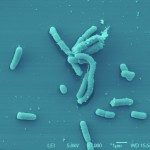Link to Pubmed [PMID] – 39978224
Link to HAL – pasteur-04957798
Link to DOI – 10.1016/j.vaccine.2025.126887
Vaccine 2025 Apr; 51(): 126887
Yersinia pestis, the causative agent of plague, remains a threat to public health worldwide. From the perspective of developing safe and effective vaccines, we present a derived version of our Y. pseudotuberculosis VTnF1 live attenuated vaccine candidate that lacks the pYV virulence plasmid coding for the Type 3 Secretion system (T3SS) and carries no antibiotic resistance cassettes (VTnF1-S). This strain, named VpYV-, fails to cause disease in immunocompromised mice when given orally, and can be considered as avirulent in such conditions. It retains a tropism for Peyer’s patches and mesenteric lymph nodes, whilst rarely reaching the spleen and liver. When compared to VTnF1-S, VpYV- elicited equivalent production of IgG directed to the F1 antigen, but less IgG directed to other Yersinia antigens. A single oral dose of VpYV- induced 100 % protection against bubonic and pneumonic forms of plague. Four months after vaccination, the protection induced by VpYV- had decreased more than that induced by VTnF1-S. Furthermore, VpYV- was 30 % less protective against F1-negative Y. pestis, revealing that the T3SS components encoded by pYV are mandatory to obtain a large spectrum protection. Finally, VTnF1-S and VpYV- were compared for their ability to induce immediate immune activity against co-infecting Y. pestis, which could be a potential therapeutic strategy against early-stage infections. Like the historical Y. pestis vaccine EV76, VTnF1-S was able to induce such a protection. The process involved nutritional immunity in serum, indicating a fast activation of innate immune mechanisms. By contrast, VpYV- failed to protect mice, revealing an importance of the T3SS in this mechanism. Overall, VTnF1 and its derivative strain VpYV-, offer a choice between better vaccine performance or greater vaccine safety. They represent useful tools to prevent and treat Y. pestis infection in healthy or immunocompromised individuals.




